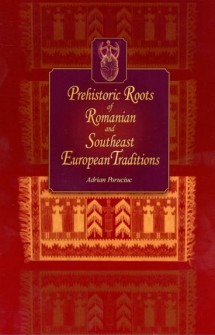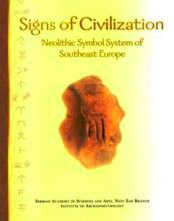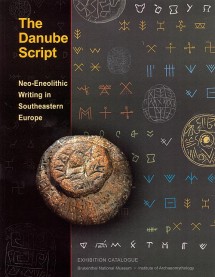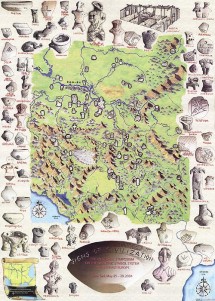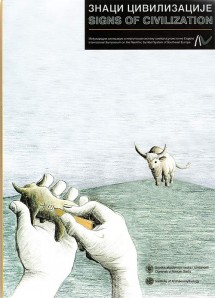The Danube Script: Neo-Eneolithic Writing in Southeastern Europe
Museum of History, CASA Altemberger, Brukenthal National Museum, Sibu, Romania
May 18-20, 2008
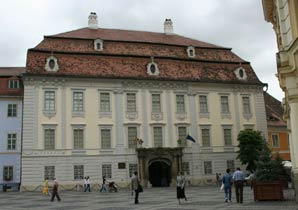
Brukenthal National Museum, Sibiu, Romania
Our sincere gratitude to Professor Sabin Adrian Luca, Dr. Cosmin Suciu and the entire staff of the Brukenthal National Museum and Casa Altemberger for making this exhibition and symposium a reality.
We are also grateful to the directors of the Romanian museums who generously allowed our staff from the Institute of Archaeomythology, especially Jacob Appelbaum, to photograph inscribed artifacts in their collections for this exhibition. The participating museums are: Brukenthal National Museum, Sibiu; National History Museum of Transylvania, Cluj-Napoca; National Museum of History, Bucharest; “Vasile Pârvan” Museum, Bârlad; Institute of Archaeology, Iasi; Braila Museum of Archaeology and History, Braia; Department of Archaeology, “Al.I. Cuza” University, Iasi; Museum of History and Archaeology, Piatra-Neamt; Museum of Banat, Timisoara;
Museum of Banat Mountain Area, Resita.
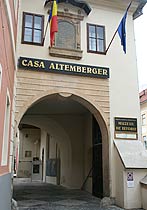
Museum of History
A special Thank You to artist and anthropologist Daniela Bulgarelli for the excellent paintings of inscribed figurines from throughout Southeast Europe provided by Dr. Marco Merlini of the M.U.S.E.U.M. Project, Rome, Italy. Ms. Bulgarelli’s paintings were displayed as part of the exhibition of inscribed images in the Museum of History.
We are also grateful to the international group of scholars who gathered to take part in the symposium on the Danube Script that took place at Casa Altemberger of the Brukenthal National Museum, May 18-20, 2008. Their abstracts and selected photos from the symposium are featured below. Thanks to our entire Board of Directors for their dedicated work and to Greg Dexter and Adam Giacinto who tirelessly documented the unfolding events in Sibiu.
Symposium Abstracts
Introducing the Danube Script
Joan MARLER
Executive Director
Institute of Archaeomythology
Sebastopol, California, USA
The idea that the earliest agrarian societies of Europe developed a script during the sixth and fifth millennia BC challenges the prevailing canon that writing began in Mesopotamia two thousand years later. In order to engage in meaningful dialogue about the development of writing technology in Neolithic Europe, it is essential to examine prevailing concepts about what constitutes writing.
This presentation gives a brief introduction to the scope and overarching considerations of our symposium concerning the fascinating subject of the earliest literacy in Europe.
Changing the Canon:
Research on Ancient Writing Systems Beyond the Mesopotamian Bias
Dr. Harald HAARMANN
Director of European branch
Institute of Archaeomythology
Luumäki, Finland
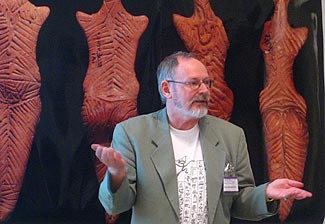 In many domains of modern science, as well as in writing research, theory-making readily adheres to the application of prototypical models that supposedly have explanatory potential for all known cases of a studied subject. According to traditional concepts of culture chronology, the threshold of civilization was first passed in Mesopotamia in the late fourth millennium BCE. The traditional argument for the emergence of writing is that this technology was introduced to facilitate the recording of information in early state bureaucracy.
In many domains of modern science, as well as in writing research, theory-making readily adheres to the application of prototypical models that supposedly have explanatory potential for all known cases of a studied subject. According to traditional concepts of culture chronology, the threshold of civilization was first passed in Mesopotamia in the late fourth millennium BCE. The traditional argument for the emergence of writing is that this technology was introduced to facilitate the recording of information in early state bureaucracy.
Along the lines of ex oriente lux, a kind of circular reasoning, stemming from the era of romantic historicism at the beginning of the 19th century, has dominated Mesopotamian studies up to the present. However, the vision of Mesopotamia as the “cradle of civilization” and of the earliest writing is no longer valid. Foundations for high culture and the early use of a script, predating Sumerian writing, have been identified for predynastic Egypt. Certain conditions about writing in Mesopotamia do not apply to the cultural environment in ancient Egypt.
Nor do they apply to another region with early writing technology which also predates the development in Mesopotamia, and that is Southeastern Europe. The signs and symbols from Neolithic societies of the Danube civilization, dated to the sixth millennium BCE, have opened yet another fruitful horizon for the debate about the origins of writing.
Modern writing research needs a revision of its conventional conceptualizations and an extension of the range of issues studied. Insights about the early experiments with writing in the Danube civilization are already being discussed in domains such as the history of information technology, the philosophy of language and the theory of culture. The pressing need for writing research to keep up with the pace of current scientific activities in the mentioned disciplines calls for the elaboration of a new paradigm beyond the Mesopotamian bias:
- a revised cultural chronology for the emergence of ancient civilizations;
- a revised typology of writing systems; and
- a revised conceptualization of sign use in the Neolithic of Southeastern Europe, untainted by misleading notions such as “potters’ marks” or “pre-writing.”
Key Features of the Danube Script Based on the Databank DatDas
Marco MERLINI
Director, Prehistory Knowledge Project
Rome, Italy
This presentation will provide documentary and statistical evidence concerning inventory, fabric, pattern of features and organizational principles of the Danube script established upon the results of the databank DatDas (Databank for the Danube script), especially created to document it. DatDas documents 818 objects, 953 inscriptions (some artifacts have more than one inscription), and 4,408 actual signs. As main a feature, DatDas records not only general and archaeological data concerning objects bearing signs (the site, information on the discovery, museum documentation data, relative and absolute dating, formal and techno-morphological information on the object, and so on), but above all distinct semiotic information on the inscribed artifacts, the inscriptions, and the signs.
The Legacy of the Danube Script to the East of the Carpathians During the Early Bronze Age (3400-2300 BC)
Mikhail VIDEIKO
Institute of Archaeology
National Academy of Sciences,
Kiev, Ukraine
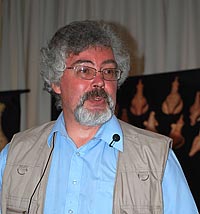 During the Copper Age (5000-3500/3400 BC) some elements of the Danube script were used and developed by the Trypillia Culture. At the beginning of the Early Bronze Age (3400-3200 BC) we can observe a differentiation of the sign system in Trypillia Culture local types. The developed sign system, created by Trypillians, was a step to the creation of writing. From this period originated a few artifacts with linear inscriptions. After 3200 BC the Trypillian world fell into decay and the process of writing invention was interrupted. Old signs were used only in a few territories connected with the production of traditional painted pottery. At the same time the use of pictograms on speen-whorls flourished, similar to what existed in Anatolia.
During the Copper Age (5000-3500/3400 BC) some elements of the Danube script were used and developed by the Trypillia Culture. At the beginning of the Early Bronze Age (3400-3200 BC) we can observe a differentiation of the sign system in Trypillia Culture local types. The developed sign system, created by Trypillians, was a step to the creation of writing. From this period originated a few artifacts with linear inscriptions. After 3200 BC the Trypillian world fell into decay and the process of writing invention was interrupted. Old signs were used only in a few territories connected with the production of traditional painted pottery. At the same time the use of pictograms on speen-whorls flourished, similar to what existed in Anatolia.
After 3200/3000 BC, Late Trypillia types coexisted with the “Kurgan culture” Yamna (pit-graves) and Catacombna (catacomb graves). We can observe some categories of old signs on pottery and other artifacts of these cultures. The main successor of Trypillia, it seems, was the Catacombna Culture. Sign systems at these times were closely connected with funeral practices. Most of the Catacomb Culture pottery with signs have been found in burial contexts. Some of them were pictured on the walls of the graves. Another field of signs application was decoration of warfare.
At the same time, the Catacombna culture had contacts with distant regions in the Middle East, and some signs have analogies in this region. Such signs we can observe on pottery and slabs from Kamyana Mohyla. Very important for spreading of signs were contacts with the Maykop Culture, which originated in the Trans-Caucasian region near 3900/3600 BC with a sign system connected with Mesopotamia. On materials originating from the steppe region we can observe the coexistence and integration between the Old Europe and Eastern script traditions. One question is how was the tradition and knowledge of sign use transmitted. It seems that an important role belonged to sanctuaries, which existed at these territories from the Copper Age to Middle Ages such as at Verteba cave, Kamyana Mohyla or Marl Ride.
Clay Bread, Slates or Tablets with Signs and Symbols
Magda LAZAROVICI
Institute of Archaeology
“Al. I. Cuza” University, Iasi
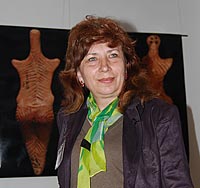 In this article we intend to analyze some clay objects from the Cucuteni-Tripolye cultural complex (Lazarovici C.-M. 2006) named as breads, or slates that might be interpreted as well as tablets. Some of them contain signs and symbols. Seven pieces have been discovered until now at Scanteia. Three, maybe four of them have signs or symbols. Similar pieces have been found in other Cucuteni A sites, such as Trusesti, Habasesti or Toflea. It is possible that other similar pieces belong to different other sites, but until now these have not been in our direct attention. Pieces from Habasesti seem to be without any sign or symbol, but those from Trusesti and Toflea contain such elements. During Cucuteni B phase such pieces are present only at Ghelaiesti-Nedeia.
In this article we intend to analyze some clay objects from the Cucuteni-Tripolye cultural complex (Lazarovici C.-M. 2006) named as breads, or slates that might be interpreted as well as tablets. Some of them contain signs and symbols. Seven pieces have been discovered until now at Scanteia. Three, maybe four of them have signs or symbols. Similar pieces have been found in other Cucuteni A sites, such as Trusesti, Habasesti or Toflea. It is possible that other similar pieces belong to different other sites, but until now these have not been in our direct attention. Pieces from Habasesti seem to be without any sign or symbol, but those from Trusesti and Toflea contain such elements. During Cucuteni B phase such pieces are present only at Ghelaiesti-Nedeia.
In the recently published Encyclopedia of Trypillya Civilization (2004), other similar pieces, simple or with signs and symbols, have been presented in a very suggestive way. With this occasion we intend to focus more on the context of the discovery, to analyze the signs and symbols and to sketch some hypotheses related with the use of these sorts of pieces in the Cucuteni-Tripolye cultural complex.
Danube Script: The Intersection between Language, Archaeology, and Myth
Miriam Robbins DEXTER
University of California, Los Angeles, California, USA
Building upon the theory that the Danube (Old European) script was used for religious, and not economic purposes, this paper discusses the fact that the script—the earliest form of writing yet discovered—stands at the intersection between the earliest written language, archaeology, and religion/myth. Although many of the symbols of this script cannot be interpreted with certainty, this paper theorizes that one of the core symbols of the Script, the V—one of the most productive symbols in terms of the multiplicity of diacritics—can indeed be interpreted. This paper relates this to the female pubic triangle, to excavated Neolithic and Chalcolithic female figures from Southeast Europe and elsewhere, and to early historic iconography and text.
The Signs: Typology, Context, Means
Radian Romus ANDREESCU
National Museum of History
Bucharest, Romania
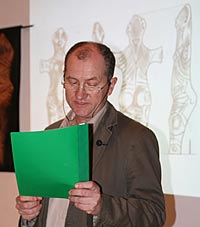 Each year several artifacts wearing all kinds of signs are discovered during archaeological research. The artifacts are made of diverse materials, like: clay, bone or stone. The signs are of an amazing diversity. For example, the decorative motifs found on clay vessels go from simple graffiti to sophisticated geometrical motifs, painted even with gold. The anthropomorphic and zoomorphic figurines represent a special category between the artifacts. The signs found on the figurines are particular for each Neolithic culture. The figurines of the Vinca culture differ from those of the Gulmelnita or Cucuteni cultures from the point of view of decoration and morphology. A refined analysis concerning the signs on Gulmelnita figurines shows that there existed certain patterns used for figurine decoration.
Each year several artifacts wearing all kinds of signs are discovered during archaeological research. The artifacts are made of diverse materials, like: clay, bone or stone. The signs are of an amazing diversity. For example, the decorative motifs found on clay vessels go from simple graffiti to sophisticated geometrical motifs, painted even with gold. The anthropomorphic and zoomorphic figurines represent a special category between the artifacts. The signs found on the figurines are particular for each Neolithic culture. The figurines of the Vinca culture differ from those of the Gulmelnita or Cucuteni cultures from the point of view of decoration and morphology. A refined analysis concerning the signs on Gulmelnita figurines shows that there existed certain patterns used for figurine decoration.
The signs are extremely varied considering also the material on which they are engraved. In this way, the signs on the decorated vessels are combined with great variety. In certain phases of the Neolithic cultures, on the back of vessels, all sorts of sign combinations have been made. Clay weights also wear different signs which sometimes form a series of resembling signs. Bone artifacts, such as little plates, rarely have certain incised or excised signs. The moulds or seals made of clay have curious and varied incised or excised signs. Strange clay objects, with uncertain function, also wear different signs on them. Deciphering these signs is a difficult work, considering their diversity. Writing, owner marks, clothing, tattoos, symbols, are some of the meanings attributed to these signs. Beyond these interpretations, the signification of the signs is powerfully linked with the context in which they existed. The context is represented by the Neolithic civilization, which is amazing, but unfortunately not very well known and understood.
From Bull-and-Butterfly to alpha and psi
Adrian PORUCIUC
Centrul de Studii Indoeuropene si Balcanice, Facultatea de Litere
Universitatea “Al. I. Cuza,” Iasi, Romania
The Old European symbols of bull and butterfly, which often occurred together (as Marija Gimbutas pointed out), are now well-known to specialists in archaeomythology. Also, the gradual stylization of an archaic bull-pictogram into the sign that was to become the alpha of the Greek alphabet has been thoroughly discussed. This author hypothesizes that a similar process took place in the case of an Old European butterfly-pictogram, which grew into an Aegean ideogram that has been interpreted as “double-axe.” That ideogram can have something to do with the “invention” of the Greek phonogram psi, which has no Phoenician antecedent. Such an assumption is based not only on the shape of the letter under discussion, but also on the fact that psi opens the written form of Greek psyche, a word that meant not only ‘soul’ but also ‘butterfly.’
Parsing the Past: Visual Marks as Cultural Metaphors
Susan MOULTON
Art History Department
Sonoma State University
Rohnert Park, California, USA
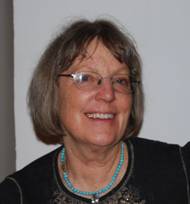 This paper proposes that in order to understand Neolithic inscriptions, such as those from Tartaria or Turdas, it is necessary to consider the human association with “place,” and the views of metaphorical communication as analogous to the transformative powers of nature itself. Signs and symbols for nature-based cultures cannot be interpreted independently from geographical contexts and features which often define culture and an individual’s role within it. The sacred and the mundane cannot be disaggregated as they traditionally are in patriarchal, Eurocentric culture of recent time. Using explanations from extant indigenous people, Prof. Moulton proposes that we must apply a synaesthic approach to decoding marks from the past, noting that their cultural language-identity, like that of extant practicing native peoples, is created through an integral interaction with place and is indistinguishable from context which evolves through time. Marks function as mnemonic devices, verbal analogies, and glyphic codes derived from shared knowledge, experience and history observed across generations. More than alphabets or rational signs, they are living elements whose meaning requires direct experience of place and commitment to sacred interaction within a specific ecosystem.
This paper proposes that in order to understand Neolithic inscriptions, such as those from Tartaria or Turdas, it is necessary to consider the human association with “place,” and the views of metaphorical communication as analogous to the transformative powers of nature itself. Signs and symbols for nature-based cultures cannot be interpreted independently from geographical contexts and features which often define culture and an individual’s role within it. The sacred and the mundane cannot be disaggregated as they traditionally are in patriarchal, Eurocentric culture of recent time. Using explanations from extant indigenous people, Prof. Moulton proposes that we must apply a synaesthic approach to decoding marks from the past, noting that their cultural language-identity, like that of extant practicing native peoples, is created through an integral interaction with place and is indistinguishable from context which evolves through time. Marks function as mnemonic devices, verbal analogies, and glyphic codes derived from shared knowledge, experience and history observed across generations. More than alphabets or rational signs, they are living elements whose meaning requires direct experience of place and commitment to sacred interaction within a specific ecosystem.
Balkan Neolithic and Early Copper Networks of Communication
Lolita NIKOLOVA
International Institute of Anthropology
University of Utah
Salt Lake City, Utah USA
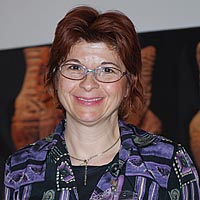 The goal of my presentation will be to structure the gradual development of the Neolithic and Early Copper Communication Network in the Balkans as an inter-cultural system with multiple external links and transformations. Since material culture gives us a fragmentary knowledge of the past, the construction of models of communication networks may approach more advanced understanding the everydayness of the people and communities who lived in the Balkans in the later seventh millennium cal BCE until the mid-fifth millennium cal BCE. We will emphasize the demographic boom on the border of the 7th-6th millennium (Karanovo I—Starcevo horizon), the graduate development of complex societies during the sixth millennium, and the flourishing of cultures in earlier fifth millennium cal BCE (Karanovo I-V, Starcevo, Vinca, Boyan, Gradeshnitsa, etc.). The symbolic systems of communication will be outlined including ritual objects, prestige and trade objects. The signs will be analyzed as an integrative part of the symbolic communication systems. Recent knowledge from the fields of social psychology and social anthropology would possibly help to better understand their function in prehistoric society.
The goal of my presentation will be to structure the gradual development of the Neolithic and Early Copper Communication Network in the Balkans as an inter-cultural system with multiple external links and transformations. Since material culture gives us a fragmentary knowledge of the past, the construction of models of communication networks may approach more advanced understanding the everydayness of the people and communities who lived in the Balkans in the later seventh millennium cal BCE until the mid-fifth millennium cal BCE. We will emphasize the demographic boom on the border of the 7th-6th millennium (Karanovo I—Starcevo horizon), the graduate development of complex societies during the sixth millennium, and the flourishing of cultures in earlier fifth millennium cal BCE (Karanovo I-V, Starcevo, Vinca, Boyan, Gradeshnitsa, etc.). The symbolic systems of communication will be outlined including ritual objects, prestige and trade objects. The signs will be analyzed as an integrative part of the symbolic communication systems. Recent knowledge from the fields of social psychology and social anthropology would possibly help to better understand their function in prehistoric society.
Are the Tartaria Tablets an Enigma?
Gheorghe LAZAROVICI
Prehistory Department
“Eftime Murgu” University,
Resita, Romania
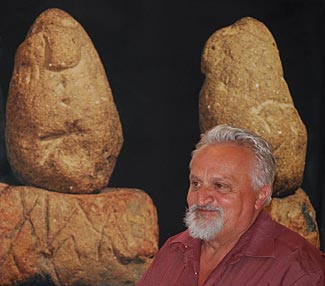 This article is a critical response to a paper presented by Iuliu Paul (2007) entitled “Enigma tablitelor de la Tartaria.” In DEX (Dictionarul explicativ al Limbii Romane), enigma = “a thing difficult to be understand, secret, mystery; puzzle, enigma.” In Webster’s New World College Dictionary, enigma = “a perplexing, usually ambiguous statement, a perplexing, baffling or seemingly inexplicable matter, mystery.”
This article is a critical response to a paper presented by Iuliu Paul (2007) entitled “Enigma tablitelor de la Tartaria.” In DEX (Dictionarul explicativ al Limbii Romane), enigma = “a thing difficult to be understand, secret, mystery; puzzle, enigma.” In Webster’s New World College Dictionary, enigma = “a perplexing, usually ambiguous statement, a perplexing, baffling or seemingly inexplicable matter, mystery.”
Paul’s paper is in two parts: a) refers to an old excavation made 19 years ago by I. Paul at Tartaria and the author’s attempt to sustain the idea of an enigma regarding the Tartaria tablets; and b) discusses some pieces discovered at Ocna Sibiului and Daia Romana. From the first sentence of the mentioned paper, Professor Iuliu Paul specifies that the Tartaria tablets created a storm in the archaeological literature. Our paper will debate problems related with the title “enigma.” The readers have the right to know another opinion and to realize what and how is set in place where a theory was demolished.
The paper in question was delivered by I. Paul on 23 May 2007 at West University, Timisoara, when he was granted the “Doctor Honoris Causa” title.
Some Aspects of the Tartaria Issue
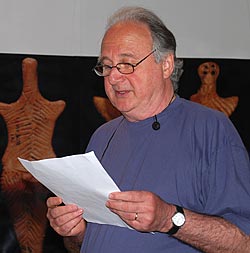 Attila LASZLO
Attila LASZLO
Archaeology Department
“Al. I. Cuza” University, Iasi
Nicolae Vlassa’s discoveries at Tartaria, especially the clay tablets with pictographic signs, raised in the beginning lively disputes among specialists with regard to the authenticity of the things and to their stratigraphic position, their cultural belonging, their significance and chronological value. The author of this paper tries to answer some of the questions as attendant in 1961, being a student, alongside with Nicolae Vlassa, to the excavations at Tartaria. (photo by Greg Dexter)
Symbolic Signs on Ceramic Objects from the Eneolithic Settlement (Precucuteni Culture) from Isaiia (Iasi County)
Nicolae URSULESCU (paper read by Felix Tencariu)
Director,Center of Interdisciplinary Archaeohistorical Studies, Faculty of History, Archaeology Department, “Al. I. Cuza” University, Iasi
Nicolae URSULESCU and Felix TENCARI
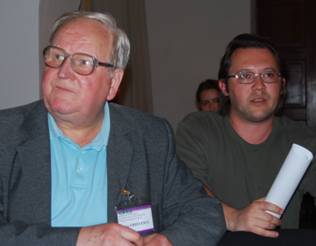
Nicolae URSULESCU and Felix TENCARI
Among the artifacts discovered in the Precucuteni site of Isaiia which hold a special signification, seventeen objects stand out through their incised signs, which represent something different than the usual decoration. This paper analyzes in detail these artefacts in order to reveal their signification. The spatial analysis shows that this kind of discovery is present in every dwelling, in very small numbers (usually one or two), especially in the vicinity of ovens or hearths, a fact which underlines their cultic significance. Of the objects inscribed with signs, there are nine pots, five miniature thrones, two clay tablets and one clay statuette. On the pots, the signs are inscribed on the bottom (in six cases), or on the upper flat side of lid handles (in two cases). Considering the rarity of the miniature thrones, one notices the high frequency of inscribed signs on their seat; in one case the signs are present also on the invisible side (the base). At the cult complex of Isaiia, such signs are present on two of the thirteen miniature thrones found there and on one of the twenty-one statuettes. This represents further evidence for attributing a special character to these signs which are found only on certain artefacts.
On ten of the analyzed artefacts we identified one sign, while the rest of the artefacts contained compositions of signs which, in some cases, are considered to be mythograms.
A certain thematic variety has been noticed, but the solar motif is the most frequent, expressed in either an abstract or realistic manner. Also identified are schematic anthropomorphic silhouettes; the trident; the grid; concentric arches; the Y sign Y and various compositions. In general, the signs on the ceramic artefacts from Isaiia do not have analogies with the already published signs from the Precucuteni culture, but rather with those from the areas of Vinca, Turdas and Boian-Gumelnita cultures, with which the bearers of the Precucuteni culture had close relations.
In conclusion, the authors consider that the Precucuteni culture has to be placed among the Eneolithic civilisations in Romanian territory where the presence of symbolic signs on ceramic artefacts is testified. An exhaustive publication and a rigorous systematisation of the symbolic signs on Precucuteni ceramic objects are necessary in order for their real significance to be established.
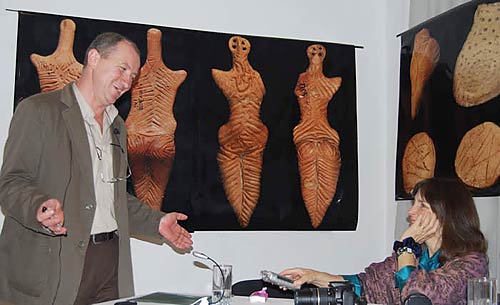
Radian Andreescu and Joan Marler
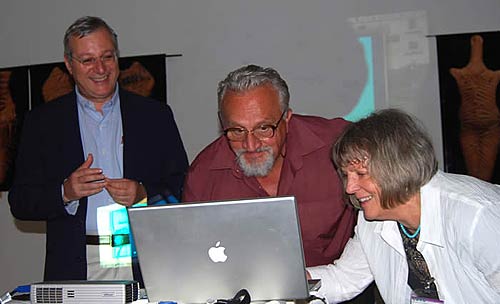
Marco Merlini, Gheorghe Lazarovici, Susan Moulton
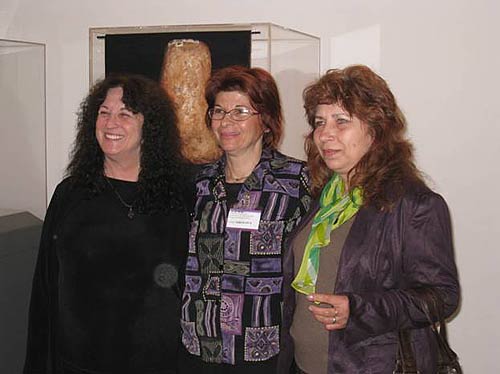
Miriam Robbins Dexter, Lolita Nikolova, Magda Lazarovici
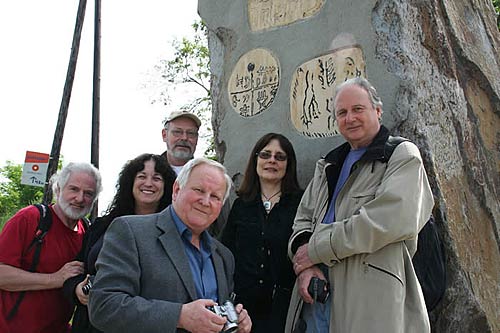
Visit to the Tartaria Monument:
Greg Dexter, Miriam Robbins Dexter, Harald Haarmann, Joan Marler, Attila Laszlo, Nicolae Ursulescu
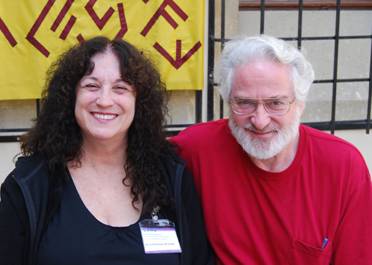
Miriam Robbins Dexter and Greg Dexter (our hardworking staff photographer)
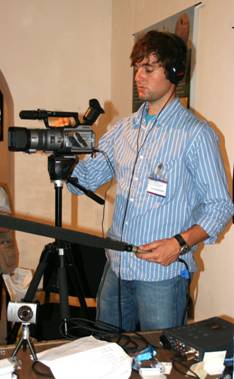
Adam Giacinto, our phenomenal
videographer
and indispensible assistant
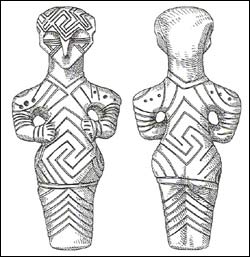 This interdisciplinary symposium was organized in collaboration with the Novi Sad Branch of the Serbian Academy of Sciences and Arts and was held at its formal facility in Novi Sad. We would like to thank President Zoran Kovačević, Professor Dr. Bogdan Brukner, and the entire staff of the Novi Sad Branch of SASA for generously hosting this international symposium.
This interdisciplinary symposium was organized in collaboration with the Novi Sad Branch of the Serbian Academy of Sciences and Arts and was held at its formal facility in Novi Sad. We would like to thank President Zoran Kovačević, Professor Dr. Bogdan Brukner, and the entire staff of the Novi Sad Branch of SASA for generously hosting this international symposium.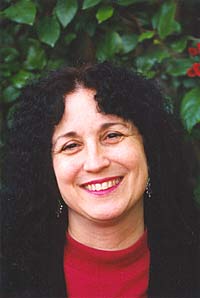 Miriam Robbins Dexter, Ph.D., holds a B.A. in Classics and a Ph.D. in Indo-European Studies (comparative linguistics, archaeology and mythology), from the University of California, Los Angeles. For thirteen years, she taught courses in Latin, Greek, and Sanskrit language and literature in the department of Classics at the University of Southern California, and is presently teaching at both UCLA and Antioch University in Los Angeles. She has authored several journal and encyclopedia articles on ancient female figures and wrote a new Introduction to The Eye Goddess (1991) by O.G.S. Crawford. She is the author of Whence the Goddesses: A Source Book (1990), and co-edited two collections of articles: Varia on the Indo-European Past: Papers in Memory of Marija Gimbutas (1997); and a monograph of Dr. Gimbutas’ own collected articles, The Kurgan Culture and the Indo-Europeanization of Europe: Selected articles from 1952 to 1993 (1997). She also edited and supplemented The Living Goddesses by Marija Gimbutas (UC Berkeley Press, 1999).
Miriam Robbins Dexter, Ph.D., holds a B.A. in Classics and a Ph.D. in Indo-European Studies (comparative linguistics, archaeology and mythology), from the University of California, Los Angeles. For thirteen years, she taught courses in Latin, Greek, and Sanskrit language and literature in the department of Classics at the University of Southern California, and is presently teaching at both UCLA and Antioch University in Los Angeles. She has authored several journal and encyclopedia articles on ancient female figures and wrote a new Introduction to The Eye Goddess (1991) by O.G.S. Crawford. She is the author of Whence the Goddesses: A Source Book (1990), and co-edited two collections of articles: Varia on the Indo-European Past: Papers in Memory of Marija Gimbutas (1997); and a monograph of Dr. Gimbutas’ own collected articles, The Kurgan Culture and the Indo-Europeanization of Europe: Selected articles from 1952 to 1993 (1997). She also edited and supplemented The Living Goddesses by Marija Gimbutas (UC Berkeley Press, 1999).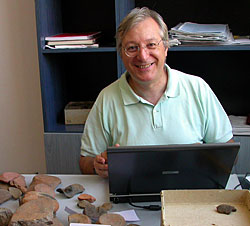 Marco Merlini, Ph.D., is a cultural manager, journalist and archaeo-semiologist. He is Executive Director of the InnovaNet and EURO INNOVANET research institutes and is General Director of the Prehistory Knowledge Project in Rome, Italy. He is the Coordinator of M.U.S.E.U.M. — the network of the archaeological, historical and prehistoric museums of European capital cities — and the “Virtual Museum of European Roots.” He is also Director of Communications of the Institute of Archaeomythology and is the author of La scrittura è nata in Europa (2004) and numerous articles on the Danube script.
Marco Merlini, Ph.D., is a cultural manager, journalist and archaeo-semiologist. He is Executive Director of the InnovaNet and EURO INNOVANET research institutes and is General Director of the Prehistory Knowledge Project in Rome, Italy. He is the Coordinator of M.U.S.E.U.M. — the network of the archaeological, historical and prehistoric museums of European capital cities — and the “Virtual Museum of European Roots.” He is also Director of Communications of the Institute of Archaeomythology and is the author of La scrittura è nata in Europa (2004) and numerous articles on the Danube script.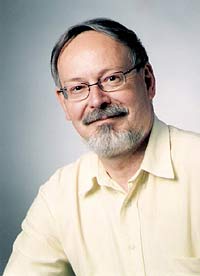 Harald Haarmann, Ph.D., earned his doctorate in linguistics at Bonn University in 1970 and his Habilitation at Trier University in 1979 with a two-volume study on the linguistics of Balkan languages. He has received a number of prestigious fellowships, has taught at universities in Germany and Japan, and is currently working as an independent scholar doing research in the fields of language and culture studies, archaeomythology, and archaeolinguistics. As a linguist, he is fluent in German, English, French, Italian, Catalan, Spanish, Portuguese, Finnish, and Japanese, and has a working knowledge of Swedish, Dutch, Estonian, Russian, Bulgarian, Serbian, Romanian, ancient Greek, Latin, Occitan, and Welsh. His publications include more than forty books in German, English, Spanish, Japanese, Chinese and Italian in the following fields: general linguistics, contact linguistics, sociolinguistics, comparative linguistics, history of writing, culture studies, ethnic studies, archaeology, history of religion and mythology. Among these monographs are several series: Five studies on the languages of Europe (1975, 1979-84, 1993); four studies on the global history of writing (1990, 1992, 1995, 2002); eight studies on the languages and peoples of the world (3 vols. in 2001, 2 vols. in 2002, 2 vols. in 2004, 1 vol. in 2005). He has authored c. 190 articles and essays in scientific journals and other publications, has edited and co-edited numerous journal volumes on linguistics, and has recently co-edited the Wieser encyclopaedia of the languages of Western Europe. Dr. Haarmann is a member of the research team of the “Research Centre on Multilingualism” in Brussels, and is a member of the EU scientific committee supervising “Euromosaic III,” providing documentation of regional languages and cultures in the new EU member states. He is the recipient of numerous awards and honors including the “Prix logos,” (from the Association européenne des linguistes et des professeurs de langues, Paris) and the “Premio Jean Monnet” award (for essay writing, Genova, Italy).
Harald Haarmann, Ph.D., earned his doctorate in linguistics at Bonn University in 1970 and his Habilitation at Trier University in 1979 with a two-volume study on the linguistics of Balkan languages. He has received a number of prestigious fellowships, has taught at universities in Germany and Japan, and is currently working as an independent scholar doing research in the fields of language and culture studies, archaeomythology, and archaeolinguistics. As a linguist, he is fluent in German, English, French, Italian, Catalan, Spanish, Portuguese, Finnish, and Japanese, and has a working knowledge of Swedish, Dutch, Estonian, Russian, Bulgarian, Serbian, Romanian, ancient Greek, Latin, Occitan, and Welsh. His publications include more than forty books in German, English, Spanish, Japanese, Chinese and Italian in the following fields: general linguistics, contact linguistics, sociolinguistics, comparative linguistics, history of writing, culture studies, ethnic studies, archaeology, history of religion and mythology. Among these monographs are several series: Five studies on the languages of Europe (1975, 1979-84, 1993); four studies on the global history of writing (1990, 1992, 1995, 2002); eight studies on the languages and peoples of the world (3 vols. in 2001, 2 vols. in 2002, 2 vols. in 2004, 1 vol. in 2005). He has authored c. 190 articles and essays in scientific journals and other publications, has edited and co-edited numerous journal volumes on linguistics, and has recently co-edited the Wieser encyclopaedia of the languages of Western Europe. Dr. Haarmann is a member of the research team of the “Research Centre on Multilingualism” in Brussels, and is a member of the EU scientific committee supervising “Euromosaic III,” providing documentation of regional languages and cultures in the new EU member states. He is the recipient of numerous awards and honors including the “Prix logos,” (from the Association européenne des linguistes et des professeurs de langues, Paris) and the “Premio Jean Monnet” award (for essay writing, Genova, Italy).